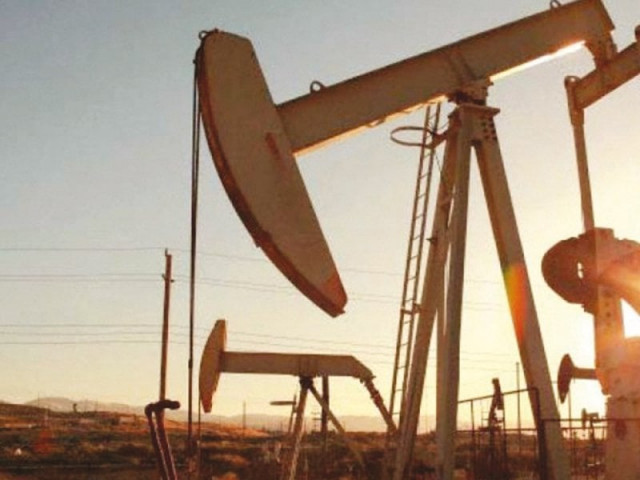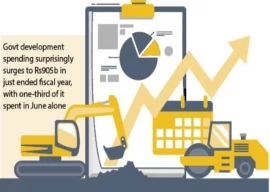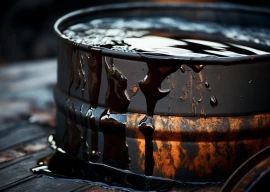
Pakistan has potentially big deposits of hydrocarbon, but oil and gas discoveries have been slow, forcing the country to rely heavily on oil imports.
In an effort to encourage and expedite exploration activity, the Pakistan Peoples Party (PPP) government in its 2008-13 tenure framed the 2012 petroleum policy and gave some incentives to the oil and gas companies.
Consequently, oil production shot up to 100,000 barrels per day (bpd) from 64,000 bpd. However, gas output remained more or less stagnant at 4 billion cubic feet per day (bcfd) for over a decade.
Now, the current PML-N government has designed a five-year gas import strategy to cope with the deficit. The PPP administration had also made several attempts to import gas, but the plan did not meet success.
Petroleum and Natural Resources Minister Shahid Khaqan Abbasi told a meeting on energy reforms, which was also attended by a World Bank representative, that the government had planned to import 4 bcfd of gas, which was equal to the domestic production, over the next five years.
The national economy has suffered greatly from the energy crisis over the past few years. Several industrial units have either been shut down or forced to shift to other countries in the wake of prolonged power outages.
For handling imports, the first liquefied natural gas (LNG) terminal has already been set up in the country and is processing imports from Qatar. With handling capacity of 600 million cubic feet per day (mmcfd), it is providing gas to industrial units, fertiliser plants, power producers and compressed natural gas (CNG) outlets.
A senior official of the Ministry of Petroleum said under the import plan, three long pipelines would be laid and six LNG terminals would be built.
Work on the second LNG terminal, with the same 600 mmcfd handling capacity, is also under way that will be completed in June this year. LNG supply from this terminal has been allocated to three LNG-based power plants being set up in Punjab.
“Third terminal is being set up by Turkish firm Global Energy and fourth terminal is being developed by Shell,” the official said.
Among the planned LNG pipelines, first pipeline that could carry 1.2 bcfd has already been laid. It is supplying LNG from the first terminal where cargoes are being brought from Qatar and by Gunvor.
The board of directors of Sui Northern Gas Pipelines Limited (SNGPL) has approved the laying of second gas transmission line with the same 1.2 bcfd capacity. This pipeline will be linked with the terminals being set up by Global Energy and Shell.
The third pipeline called North-South pipeline will be built by Russia, which will run from Karachi to Lahore.
At present, Pakistan’s natural gas production of 4 bcfd is mostly being consumed by domestic consumers. In future, the government has planned to provide this gas to the domestic consumers only whereas imported gas will be supplied to commercial and industrial consumers.
According to the official, after the China-Pakistan Economic Corridor (CPEC) becomes fully functional and the industrial base widens, the government will need to provide gas to feed the industries. Under this plan, imported gas will be transmitted to the industrial units to be set up in the special economic zones under CPEC.
Energy reforms
In a bid to smoothly implement the gas import plan, the government is working on reforms. As part of this programme, gas utilities - SNGPL and Sui Southern Gas Company (SSGC) – will be split into eight companies. A deadline of June 30 has been set to execute this plan.
The World Bank has suggested that Pakistan allow the private sector to utilise the existing pipeline network for the marketing and distribution of imported gas to different sectors of the economy. The government has agreed with the proposal in a bid to break the monopoly of state-run gas utilities.
The Ministry of Petroleum has been tasked with designing reforms for the downstream gas sector in coordination with key stakeholders.
These reforms entail a two-tier gas market, open and unrestricted access to gas networks (third-party access), restructuring of transmission and distribution businesses, tariff methodology to match the restructured business and end-consumer tariff and subsidy policy.
Though the government has formulated the gas import policy, it has not paid much attention to exploring fresh domestic oil and gas reserves. Already, several foreign companies have sold their assets and pulled out of Pakistan in the wake of lack of incentives and bureaucratic hurdles.
The energy sector is already under threat from the uncontrollable circular debt and further imports will pile more pressure on precious foreign currency reserves of Pakistan.
The writer is a staff correspondent
Published in The Express Tribune, May 8th, 2017.
Like Business on Facebook, follow @TribuneBiz on Twitter to stay informed and join in the conversation.


















COMMENTS
Comments are moderated and generally will be posted if they are on-topic and not abusive.
For more information, please see our Comments FAQ